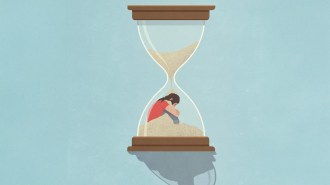Bilingual babies cue in to languages
Two native tongues better than one for infant perception
WASHINGTON — Babies living in bilingual homes get a perceptual boost by 8 months of age that may set the stage for more resilient thinking later in life, scientists reported February 18 at the American Association of the Advancement of Science annual meeting.
Infants raised bilingual from birth can distinguish not only between their two native tongues but between two languages they’ve never been exposed to, just by watching adults speak without hearing what they say, said psychologist Janet Werker of the University of British Columbia.
Babies being raised to speak one language lack these visual discrimination skills, Werker and her colleagues have found.
Given regular exposure to two languages, infants develop a general ability to track closely what they hear and see in decoding languages, Werker proposed. In the visual realm, such information may include lip movements, the rhythm of the jaw opening and closing, and the full ensemble of facial movements while talking.
Her earlier studies found that newborn babies that had been exposed prenatally to two languages prefer to listen to those languages over others and distinguish between sounds in the tongues that they regularly hear spoken.
“Bilingual infants are able to keep their languages distinct from birth and may develop an increased sensitivity to voice and face cues for different languages,” Werker said.
Early perceptual strides taken by infants in bilingual homes may represent the beginnings of an increased ability, relative to one-language speakers, to focus attention and think in complex ways later in life, suggested psychologist Ellen Bialystok of York University in Toronto. Bialystok’s group has found that among more than 400 older adults diagnosed with Alzheimer’s disease, those who speak two languages fluently are, on average, four to five years older than those who speak one language.
“Bilingual adults are better able to cope with the disease’s effects on mental function,” Bialystok proposed.
Werker’s team studied a total of 48 babies, all 8 months old, from families that spoke Spanish only, Catalan only or both Spanish and Catalan. Each infant sat on his or her mother’s lap and watched videos of three women, all bilingual in English and French, reading sentences in those languages without any sound.
Once babies got bored with clips in one language and began to look away and fidget, they were shown different clips of a woman reciting sentences either in the same language as before, or in a different tongue.
Babies from bilingual Spanish/Catalan homes homed in on faces speaking a different language and largely kept ignoring a language that they had just heard, even though both English and French were new languages to them.
Babies from Spanish-only and Catalan-only families paid little attention to switches between French and English.







